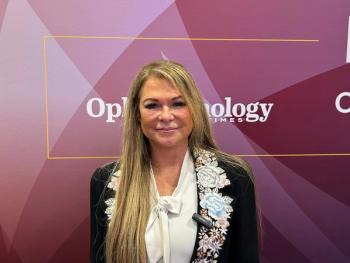
Iris registration considers pupil centroid shift, cyclotorsion
Iris registration with compensation for cyclorotation and centroid pupil shift seems to be essential for further improvement of refractive outcome and patient satisfaction. Ignoring the pupil centroid shift can lead to sub-optimal results in wavefront-driven refractive surgery.
Key Points
San Diego-Iris registration with compensation for cyclorotation and centroid pupil shift seems to be essential for further improvement of refractive outcome and patient satisfaction. Ignoring the pupil centroid shift can lead to suboptimal results in wavefront-driven refractive surgery, said Kerry D. Solomon, MD, here at the annual meeting of the American Society of Cata-ract and Refractive Surgery.
"We have all come to learn that there are different qualities of 20/20 vision," said Dr. Solomon, associate professor, Storm Eye Institute, and director, Magill Research Center for Vision Correction, Medical University of South Carolina, Charleston. "We wonder [whether] there are actual differences between customized and optimized surgeries and [whether] registration really matters."
In his practice, Dr. Solomon said, iris registration is very important because pupil centroid shift and the more common cyclotorsion are being considered.
Cyclotorsion, on the other hand, is the difference in the position of the eye between when the patient is sitting and prone. The difference has been reported in the literature to be as great as 10 to 15°, Dr. Solomon said.
"Two to five degrees certainly can have an effect on point-spread function and the overall quality of vision," he said.
When the two phenomena come together, this affects the alignment of the treatment on the pupil.
Dr. Solomon demonstrated the position of the wavefront measurement taken by aberrometry and centered over a large pupil.
"This is where we ought to be centering measurements because most of the higher-order aberrations [HOAs] exist in the periphery," he noted.
When the treatment data are transferred to the laser and the patient assumes a prone position, the center of the pupil from the information programmed into the laser is different from that obtained at the aberrometer.
"It is that mismatch that we are looking to improve upon," he said.
Iris registration differs because it maps out peripheral crypts or areas of the iris, so that, in the presence of pupil centroid shift and cyclotorsion, iris registration takes them into account, Dr. Solomon explained. With centroid shift and cyclotorsion, iris registration pulls the information back to where it should be on the eye and re-aligns the map to account for the cyclotorsion, resulting in laser energy being directed where it should to obtain better alignment of the desired treatment with the corneal area of intended treatment, he said.
"That is the difference between iris registration and customized ablations without iris registration," he said. "We see this every day in clinical practice, and we believe that this matters greatly."
In light of this importance, Dr. Solomon and his colleagues compared refractive outcomes between wavefront-guided LASIK using an excimer laser (STAR S4, Advanced Medical Optics [AMO]/VISX) with and without iris registration and determined the impact of compensation for cyclotorsion and pupil centroid shift on the refractive results.
Dr. Solomon and colleagues have observed from an average of 4° up to 10° of cyclotorsion in their retrospective chart review of patients who underwent uneventful wavefront-guided LASIK (CustomVue, AMO/VISX).
"The nasal decentration, on average, was 250 µm and as high as 500 µm," he said. "More commonly and surprisingly, we have also seen superior vertical decentration ranging from about 200 to 500 µm.
"The correlation coefficients of our outcomes are good, and we have almost a perfect correlation of our iris registration data," he added. "We are showing an expected reduction of cylinder of about 50%, such that most patients are within a tenth of a diopter for the astigmatism outcome."
An uncorrected visual acuity of 20/15 is being achieved in about 40% of patients, Dr. Solomon said.
Newsletter
Don’t miss out—get Ophthalmology Times updates on the latest clinical advancements and expert interviews, straight to your inbox.



















































.png)


